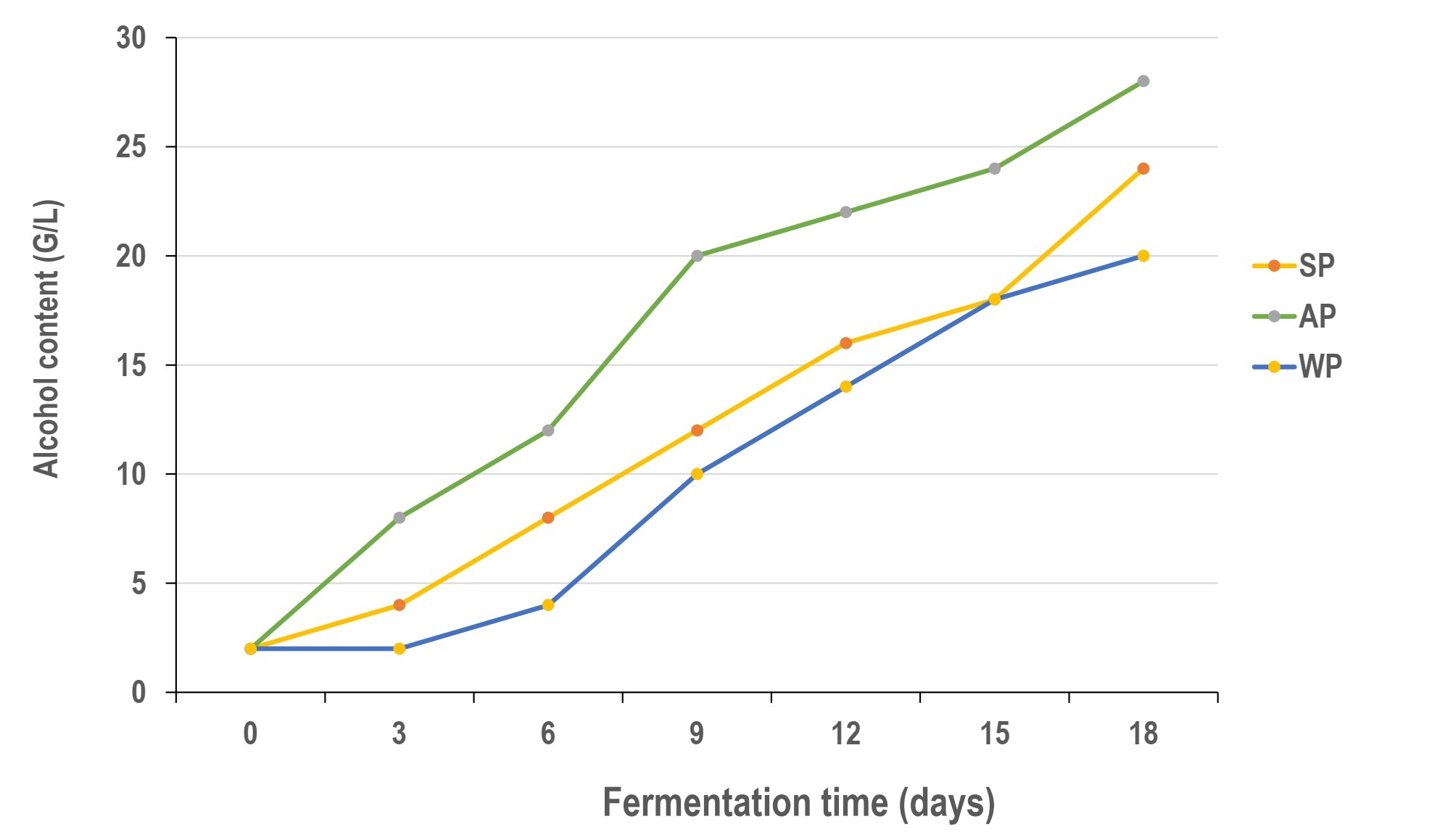The Study of Efficiency of Bioethanol Production from Sugarcane Bagasse by Cellulosic Ethanol Process
Main Article Content
Abstract
The production of bioethanol from bagasse is one of agricultural residues which are as lignocellulose material, it can be converted from reducing sugar to bioethanol feedstock. The purpose of this research was to study methods of pre-treatment sugarcane bagasse for fermentation of bioethanol production. The condition of fermentation bioethanol from sugarcane bagasse by static that incubated at room temperature and the fermentation time 18 days. The results showed that the pre-treatment sugarcane bagasse with HCl 1% could hydrolysis cellulose of sugarcane bagasse, which gave the highest glucose and xylose yield of 789.6 mg/L and 3,779 mg/L, respectively. Therefore, ethanol fermentation by Kluyveromyces marxianus TISTR5177 and initial pH of 5.0 gave maximum alcohol content 28 g/L that have the best efficiency of fermentation 21.39 % by g dried raw material. In addition, sugarcane bagasse was the optimum to use as raw material for produce bioethanol by cellulosic ethanol product because its abundance of agriculture residues from processing industry and high reducing sugar. Sugarcane bagasse residue is a suitable feedstock for bioethanol production.
Article Details
References
กรมพัฒนาพลังงานทดแทนและอนุรักษ์พลังงาน. (2558). แผนพัฒนาพลังงานทดแทน และพลังงานทางเลือก พ.ศ. 2558 – 2579. กระทรวงพลังงาน. 22 หน้า.
กุสุมาวดี ฐานเจริญ. (2559). การเพิ่มประสิทธิภาพในการผลิตเอทานอลจากน้ำอ้อยโดยยีสต์ทนอุณหภูมิสูง. รายงานวิจัยฉบับสมบูรณ์. มหาวิทยาลัยราชภัฎมหาสารคาม. 75 หน้า.
ชัชนันท์ นิวาสวงษ์ และเฉลิม เรืองวิริยะชัย. (2555). การผลิตเซลลูโลซิกเอทานอลในประเทศไทย. ว.วิทย.มข. 40(4). 1073 – 1088.
บุญช่วย ปานอินทร์ วรณี แพ่งจันทึก และจิตติ มังคละศิริ. (2560). การศึกษาความเหมาะสมของการผลิตเอทานอลจากน้ำตาลทรายดิบ และกากน้ำตาล. วารสารวิทยาศาสตร์และเทคโนโลยี. ปีที่ 25 ฉบับที่ 1. 148 – 157.
รัชพล พะวงศ์รัตน์. (2558). กระบวนการปรับสภาพเพื่อเพิ่มประสิทธิภาพการผลิตเอทานอลจากวัสดุเหลือทิ้งทางการเกษตรประเภทลิกโนเซลลูโลส. Veridian E-Journal SU, 2(1), 143-157.
วารินทร์ พิมพา จักกฤษณ์ พิมพา และเพ็ญศิริ นภีรงค์. (2555). การพัฒนากระบวนการหมักชานอ้อยด้วยจุลินทรีย์ผสมเพื่อใช้เสริมในอาหารไก่. พิษณุโลก: มหาวิทยาลัยนเรศวร.
เสรี มหาวิชัด และเฉลิม เรืองวิริยะชัย. (2012). การผลิตลิกโนเซลลูโลสิกเอทานอลจากสารละลายที่ได้จากการย่อยลำต้นมันสำปะหลังด้วยวิธีการหมักแบบกะด้วยยีสต์ Saccharomyces cerevisiae TISTR 5048. Veridian E-Journal, Science and Technology Silpakorn University. 5(3): 429-445.
สุจิตรา รวดหมวน ประภา โซ๊ะสลาม และรัชพล พะวงศ์รัตน์. (2556). การผลิตเอทานอลจากวัชพืชน้ำโดยเชื้อ Candida shehatae TISTR 5843 ด้วยกระบวนการหมักแบบกะและกึ่งกะ. Veridian E-Journal, Science and Technology Silpakorn University. 6(3): 935-948.
สุภาวดี ผลประเสริฐ. (2557). การปรับสภาพวัตถุดิบพวกลิกโนเซลลูโลสสำหรัลการผลิตเอทานอล. วารสารวิทยาศาสตร์และเทคโนโลยี. 22(5): 641-649.
อภิญญา แซ่โง้ว ชื่นจิต ประกิตชัยวัฒนา วรภา คงเป็นสุข และสุเมธ ตันตระเธียร. (2556). ผลของสติกมาสเตอรอลต่อการทนอุณหภูมิต่ำของยีสต์ทนร้อน. การประชุมวิชาการของมหาวิทยาลัยเกษตรศาสตร์ ครั้งที่ 51, 89-95.
อรุณทิพย์ เหมะธุลิน สกุลกานต์ สิมลา สุรศักดิ์ บุญแต่ง และสุดาทิพย์ อินทร์ชื่น. (2555). ความสัมพันธ์ระหว่างค่าสี (L*, a* และ b*) กับปริมาณแอนโทไซยานินในเชื้อพันธุกรรมข้าวโพดข้าวเหนียวสีม่วง. แก่นเกษตร 40 ฉบับพิเศษ 4, 59-64.
Daniel, J.B., J.A. Rincon-Moreno, J.F. Solanilla-Duque, J.A. Munoz-Hernandez and H.A. Vaquiro-Herrera. (2018). Comparison of two pretreatments methods to produce second-generation bioethanol resulting from sugarcane bagasse. Industrial Crops & Products, 122, 414-421.
Jackson de Moraes Rocha, G., Martin, C., Soares, I.B., Souto Maior, A.M., Baudel, H.M., Moraes de Abreu, C.A., (2011). Dilute mixed-acid pretreatment of sugarcane bagasse for ethanol production. Biomass Bioenergy 35, 663–670.
Knappert, D., H. Grethlein and A. Converse. (1980). Partial acid hydrolysis of cellulosic materials as a pretreatment for enzymatic hydrolysis. Biotechnology and Bioengineering. 22(7): 1449-1463.
Nukrob, N., R. Assavarachan and P. Wongputtisin. (2013). Optimization of Reducing Sugar Production from Acid Hydrolysis of Sugarcane Bagasse by Box Behnken Design. Journal of Medical and Bioengineering. 2(4): 238-241.
Paturua, J.M. (1989). By products of the cane sugar industry. An introduction to their industrial utilization. 435 pp.
Peizhou, Y., H. Zhang and S. Jiang. (2016). Construction of recombinant sestc Saccharomyces cerevisiae for consolidated bioprocessing, cellulase characterization, and ethanol production by in situ fermentation. 3 Biotech. 6(192): 1-11.
Sun, Y. and J. Cheng. (2002). Hydroloysis of lignocellulosic materials for bioethanol production review. Bioresour. Technol. 83: 1-11.


